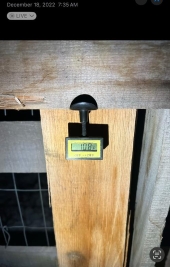Thanks for your reply and kind words.
William Bronson wrote:I believe you mention in a previous thread that no foundation is needed for tire bales?
That alone is a huge cost saving.
I will have to peruse your blog to see how that interacts with your earthen floor.
It would have been easier to simply avoid building codes, etc,but you are unlocking regulatory barriers instead, and that is a great contribution to society.
Our engineer first drew it up on a concrete slab. We said we wanted to minimize concrete and asked for a rubble trench foundation just under the bales. He came back with a concrete foundation just under the bales, which is what we went with. The Colorado tire bale homes engineered by Mike Shealy do not use a concrete foundation, I don't think... Jim Gagnepain has posts on Permies about his build and might be able to give you more info. In retrospect, we live on highly erosive sandy loam on the face of a high desert mesa, so my hub and I are happy with the concrete-under-the-bales solution. The rebar network provided the ground for our solar and electrical systems. The wire that wraps our bales is embedded in the concrete at top and bottom. We feel like it is rock-solid and that feels good. In a million years instead of sliding into a canyon, we think our house will be like a Bisti Badlands mushroom !

William Bronson wrote:I am curious, do you think applying shotcrete or another cementious stucco before pouring a bond beam would be easier?
Also, do you think a wooded bond beam work on tire bale walls?
I am not an engineer so I can't say what can or can't work, but can only give my impressions as a layperson owner/builder. I would not put shotcrete on top of the bales before adding the bond beam, as tempting as it sounds (yes it would make the process less scary). The bond beam needs to integrate with the bales. That pour did feel very dicey. We had to thread the needle -- avoid allowing literal tons of concrete to pour into all of the cavities, while allowing the concrete to integrate with the bales. It was wired and rebarred. We stuffed big voids with dry trash and put additional mesh on the top surface to slow concrete without stopping it. In the end, it all worked!
I would not used a wooden bond beam, and I think most people walking on the stacked tire bale walls would not want to use a wooden bond beam -- the unprotected bale walls are very bouncy and wobbly! On the one hand the big blocks way a ton each, are solid as a rock, have a 4'x5' footprint, and "aren't going anywhere." On the other hand, standing on top of 3 tiers of bales stacked brickwise, you can feel them jiggle when you jump, and sway when you rock side-to-side. Before wiring our bales, we had 3 we wanted to remove. My husband was able to shove the first one off with his foot, and as it tumbled down we were surprised to see that it took the other two with it!
I can't imagine being able to build a wooden bond beam that I would trust on that type of wall.
Once the concrete bond beam was poured, the whole thing really did become monolithic.
It might be different if you were berming all the way up outside the 3 sides. But no, I would still want to know that the walls were solidly connected so I wouldn't have to even imagine a bale falling inward.
Homestead Rescue (or whatever that reality show is called) had an episode rescuing a tire bale house build in Ohio. They had a wall falling over, among other big problems. It would be a good watch for anyone tempted to cut corners...
One more resource: PSE engineering engineered our house (it was their first tire bale house). We can't legally share the plans they made for us, but they do share a couple pictures of our plans on their website at
https://www.structure1.com/tire-bale-home-engineering/ which also provides some general tire bale engineering guidelines. The first page shows the foundation-bales-bond beam connection, including the wire wrap and rebar.
And rumor has it there might be engineers in CO with Mike Shealy (R.I.P.) plans, but I don't know where or how to find them.
William Bronson wrote:Your choice to jump through the governmental hoops is admirable.
It would have been easier to simply avoid building codes, etc,but you are unlocking regulatory barriers instead, and that is a great contribution to society.
Thank you; that is our unpaid-career-in-retirement goal! But where we are, it also made it easier (possible) to obtain tire bales. In NM they are highly tracked as a hazardous waste, so we needed an environmental tire recycling permit to get the bales, and needed the building permit to get the recycling permit. I wanted the building permit anyway regardless of our building methods for the other reasons, but I'm not sure we could have gotten tire bales for this house without a permit.
In our county, building without a permit is very easy otherwise. Technically everyone in NM needs a permit; if the county doesn't require it you go through the state. The state requires a one-line county OK -- when we went to get that, even our county officials said, "Why do you want a permit? It's your land, isn't it?" Needless to say, most folks we know here built without a permit.
McKinley County NM, folks, if you are looking for a place with cheap land and permit-free potential!







